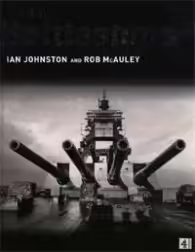The Battleships

| Издателство: | Channel 4 Books |
| Брой страници: | 192 |
| Дата на издаване: | |
| ISBN: | 0752218476 |
| SKU: | 0554970000 |
| Тегло: | 1047 грама |
| Корици: | ТВЪРДИ |
| Цена: | 28 лв. |
Battleships were the stuff of legend, projeeting might and power beyond belief. For over a century, they were the iron fists that underlined diplomacy. Where diplomacy failed, they inflicted the maximum amount of destruction that human ingenuity could devise. They were pawns in perhaps the greatest game of political one-upmanship ever played between rival nations - the product of egos, jealousy, greed, aggression, and blind ambition of nations seeking to extend their national boundaries. Before the nuclear bomb, no weapon on earth evoked so much fear, veneration and passion as the battleship.
And yet there has probably never been a class of warship that, round-for-round, in naval battles against opponents of a similar class, fought less battles, achieved less success, and had as little effect on the outcome of the major wars of the twentieth century as the battleship. Our story examines these amazingly complex and awesome weapons of destruction - from their evolution from the ships-of-the-line of Nelson's period to the super-battleships of World War II.
For well over a century, designers, engineers, scientists and naval architects - spurred on by the demands of their political and military masters - strived to produce the ultimate battleship -the impregnable floating big-gun fortress that would eclipse all others. Money from the public purse appeared limitless; shipbuilding yards, naval dockyards, steel and armament factories became major expenditures in the economies of maritime nations.
Traditional cross-channel rivals, Britain and France, were quick to apply new technologies in their navies, but by the end of the nineteenth century, Germany, driven by the ambitious Kaiser Wilhelm II, had emerged as the new naval power in Europe. The great naval arms race between Great Britain and Germany in the lead-up to World War I saw the creation of the two greatest fleets of battleships ever assembled. The head-on meeting of these two fleets in the Battle of Jutland was the largest battle between battleships in history. Lasting less than two hours, the result was inconclusive with both sides claiming victory. 'The war to end all wars' was finally resolved without another major naval battle.
And yet, immediately after World War I, so deeply ingrained in the minds of politicians and naval strategists was the need for even bigger, faster, and more powerful fleets of capital ships that a new arms race threatened. The 1922 Washington Agreement - the world's first international arms limitation treaty - created momentary international sanity, limiting the size and future numbers of battleships. But there is little doubt this conference also sowed the first seeds of discontent that eventually contributed to the outbreak of the greatest war of all - World War II.
As the aeroplane developed as a major weapon, and aircraft carriers became a practical reality, the writing was on the wall for the long-term future of the battleship. In spite of this, Japan, the nation that was the most advanced in naval aviation, was planning the two largest and most powerful battleships ever - the 71,000-ton, 18-inch gunned Yamato and Musashi. At the same time, Aclolph Hitler, in defiance of the Treaty of Versailles began building 'pocket battleships' and later, the two largest battleships ever built for the German Navy - Bismarck and Tirpitz.
The fate of these big-gun ships and the evolution of war strategies as the aircraft carrier took over as the capital ship in the world's navies, presents a dramatic and terrible story of death and destruction at unprecedented levels on the oceans of the world.
It has been fascinating to hear from British, German, Japanese, French, and American sailors, pilots and naval historians. We have been privileged to speak with many who served on battleships of opposing navies and to share with them their first-hand experiences of extraordinary survival in dangerous circumstances on the high seas. Their stories and comments provide a unique insight into the story of the battleship.
Attempting to understand and present the technical complexity of these extraordinary fighting ships, and even to scratch the surface of the political manouevring behind their creation has been a daunting task. We hope that our television series, and this book in some way succeed in presenting an informative, exciting and as accurate as possible story of these awesome and strangely charismatic weapons of war - the battleships.
Rob McAuley
.
.